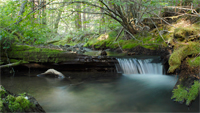Monitoring Trends
 Evaluating the watershed is a necessary and on going process towards restoration of the watershed. It allows us to find out where we need to focus our efforts to restore natural processes or improve features related to fish habitat and water quality.
Evaluating the watershed is a necessary and on going process towards restoration of the watershed. It allows us to find out where we need to focus our efforts to restore natural processes or improve features related to fish habitat and water quality.
Channel Morphology
Legacy Sediment
Negative in-stream sediment conditions watershed-wide have decreased by forty-seven percent (47%).
The changes of sediment storage are derived from mapping the fluvial geometric changes using aerial photos over a sixteen year period (1984-2000) and are consistent with other channel change field studies done in Redwood Creek watershed by Madej (1987, 1995) and Pitlick (1995).
Variation Index
Simply stated, the Variation Index (VI) measures the complexity of the channel bed; reduction of complexity occurs with excessive sediment introduction, increased complexity indicates a recovery from such a condition.
A Variation Index for the thalweg is developed for GRWC monitoring reaches within the watershed each year they are surveyed. The model we use is designed by Mary Ann Madej (USGS and Redwood National Park).
The formula for analysis is: ([Variation Index]![SD]/[Variation Index]![GRWC BF Depth])*100. Using an average bankfull width for each reach standardizes the variation in channel size.
The VI target for recovery is considered to be ‘20’ (Madej, 1999) and channels with a VI index of >20 are believed to be in recovery from excessive sediment loads.
Eighty-two percent (82%) of the stream reaches monitored withn the Gualala Watershed meet or exceed the VI target level.
Salmonid Environment
Stream Temperature
In 2009 the GRWC doubled the amount of annual monitoring sites and installed 50 temperature sites throughout the Gualala. The chart shows the MAX and MWAT temperatures for that year and is a good representation of annual temperatures for the watershed.
The data from temperature monitoring appear to show three main findings:
- Temperatures at most sites throughout the watershed are fairly stable from year to year.
- Mainstem reaches are unsuitable for coho but suitable coho temperatures are found in small tributaries especially in the North Fork basin.
- Gualala headwater temperatures are warm for salmonids but cool as the water travels downstream into the redwood region and fog belt of the watershed.
Pools
A significant factor influencing the quality of salmonid habitat is the area of primary pool habitat within a stream reach length. The generally accepted target is >40% of a reach length should be comprised of primary pools.
Primary pools are defined by their maximum depth in relationship to size or stream order. In most first and second order (small) tributaries a primary pool is considered to be any pool with a maximum depth of 2’ or greater. As the order or size of the stream increases the required primary depth increases.
Primary pool frequency is still a limiting factor to salmonids in most streams within the Gualala River Watershed. Restoration efforts to decrease anthropogenic sediment loads and increase in-stream structure to create pool scour are starting to show results.
Large Wood
Research studies have shown that large wood is a vital component of healthy stream ecosystems.
The positive role that large wood plays creating suitable salmonid habitat in riverine ecology is well documented (Martin and Benda 2001). In forested streams large wood is associated with the majority of pools and the amount of large wood in the channel has a direct affect on pool volume, pool depth and the percentage of pool area. (Elliot 1986; Murphy et al 1986; Carison et al 1990; Beechie and Wyman 1992). Large wood benefits all life stages of salmonids (Bisson et al. 1987, Sullivan et al. 1987).
Most streams within the Gualala lack large wood. The number of pieces and volume level per 1000 ft. fall far below the levels associated with healthy streams. GRWC is currently developing wood loading levels that will achieve pool formation and shelter rating targets in first to third order streams. Literature suggests that volume levels greater than 6,000 cubic feet and wood pieces greater than 150 in a 1,000 ft. reach may achieve targets.
For more information visit the GRWC Monitoring page or the data pages below.
